Ramayana
| Ramayana | |
|---|---|
 | |
| Information | |
| Religion | Hinduism |
| Verses | 24000 |
The Ramayana (/rɑːˈmɑːjənə/;[1] Sanskrit: रामायणम्, Rāmāyaṇam, pronounced [rɑːˈmɑːjəɳəm]) is an ancient Indian epic poem which narrates the struggle of the divine prince Rama to rescue his wife Sita from the demon king Ravana. Along with the Mahabharata, it forms the Sanskrit Itihasa.
The epic, traditionally ascribed to the Hindu sage Valmiki, narrates the life of Rama, the legendary prince of Kosala Kingdom, his banishment from the kingdom by his father, King Dasharatha, his travels across forests in India with his wife Sita and brother Lakshmana, the kidnap of his wife by Ravana, the demon king of Lanka, resulting in a war with him, and Rama's eventual return to Ayodhya to be crowned king.
The Ramayana is one of the largest ancient epics in world literature. It consists of nearly 24,000 verses (mostly set in the Shloka meter), divided into seven Kandas (books) and about 500 sargas (chapters). In Hindu tradition, it is considered to be the adi-kavya (first poem). It depicts the duties of relationships, portraying ideal characters like the ideal father, the ideal servant, the ideal brother, the ideal wife and the ideal king. The Ramayana was an important influence on later Sanskrit poetry and Hindu life and culture. Like the Mahabharata, the Ramayana is not just a story: it presents the teachings of ancient Hindu sages in narrative allegory, interspersing philosophical and ethical elements. The characters Rama, Sita, Lakshmana, Bharata, Hanuman and Ravana are all fundamental to the cultural consciousness of India, Nepal, Sri Lanka and south-east Asian countries such as Thailand, Cambodia, Malaysia and Indonesia.
There are many versions of the Ramayana in Indian languages, besides Buddhist and Jain adaptations; and also Cambodian, Indonesian, Filipino, Thai, Lao, Burmese and Malaysian versions of the tale.
Etymology
The name Ramayana is a tatpuruṣa compound of Rāma and ayana (going, advancing), translating to Rama's Journey.
Textual History & Structure

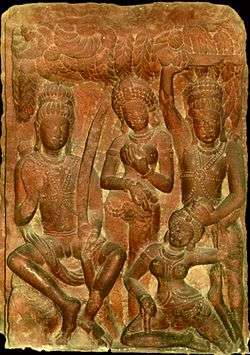
According to Hindu tradition—and according to the Ramayana itself—the epic belongs to the genre of itihasa like Mahabharata. The definition of itihāsa is a narrative of past events (purāvṛtta) which includes teachings on the goals of human life. According to Hindu tradition, Ramayana takes place during a period of time known as Treta Yuga.
In its extant form, Valmiki's Ramayana is an epic poem of some 24,000 verses. The text survives in several thousand partial and complete manuscripts, the oldest of which is a palm-leaf manuscript found in Nepal and dated to the 11th century CE. A Times of India report dated 18 December 2015 informs about discovery of a 6th-century manuscript of the Ramayana at the Asiatic Society library, Kolkata.[2] The Ramayana text has several regional renderings, recensions and subrecensions. Textual scholar Robert P. Goldman differentiates two major regional recensions: the northern (n) and the southern (s). Scholar Romesh Chunder Dutt writes that "the Ramayana, like the Mahabharata, is a growth of centuries, but the main story is more distinctly the creation of one mind."
There has been discussion as to whether the first and the last chapters of Valmiki's Ramayana were composed by the original author. Most Hindus still believe they are integral parts of the book, in spite of some style differences and narrative contradictions between these two chapters and the rest of the book.{{[3]}}
Famous retellings include Gona Budda Reddy's Ramayanam in Telugu, Kamban's Ramavataram in Tamil (c. 11th–12th century), Madhava Kandali's Saptakanda Ramayana in Assamese (c. 14th century), Krittibas Ojha's Krittivasi Ramayan (also known as Shri Rama Panchali) in Bengali (c. 15th century), Sarala Das' Vilanka Ramayana(c. 15th century)[4][5][6][7] and Balaram Das' Dandi Ramayana (also known as the Jagamohan Ramayana) (c. 16th century) both in Odia, sant Eknath's Bhavarth Ramayan (c. 16th century) in Marathi, Tulsidas' Ramcharitamanas (c. 16th century) in Awadhi (which is an eastern form of Hindi) and Thunchaththu Ezhuthachan's Adhyathmaramayanam in Malayalam.
Period
Some cultural evidence, such as the presence of sati in Mahabharata but not in the main body of Ramayana, suggests that Ramayana predates Mahabharata. However, the general cultural background of Ramayana is one of the post-urbanization period of the eastern part of north India and Nepal, while Mahabharata reflects the Kuru areas west of this, from the Rigvedic to the late Vedic period.
By tradition, the text belongs to the Treta Yuga, second of the four eons (yuga) of Hindu chronology. Rama is said to have been born in the Treta yuga to king Dasharatha in the Ikshvaku dynasty.
The names of the characters (Rama, Sita, Dasharatha, Janaka, Vashista, Vishwamitra) are all known in late Vedic literature. However, nowhere in the surviving Vedic poetry is there a story similar to the Ramayana of Valmiki. According to the modern academic view, Vishnu, who, according to bala kanda, was incarnated as Rama, first came into prominence with the epics themselves and further, during the puranic period of the later 1st millennium CE. Also, in the epic Mahabharata, there is a version of Ramayana known as Ramopakhyana. This version is depicted as a narration to Yudhishthira.
There is general consensus that books two to six form the oldest portion of the epic, while the first and last books(Bala Kanda and Uttara Kanda, respectively) are later additions. The author or authors of Bala Kanda and Ayodhya Kanda appear to be familiar with the eastern Gangetic basin region of northern India and with the Kosala and Magadha region during the period of the sixteen Mahajanapadas, based on the fact that the geographical and geopolitical data accords with what is known about the region. The knowledge of the location of the island of Lanka also lacks detail. Basing his assumption on these features, archeologist Hasmukh Dhirajlal Sankalia has proposed a date of the 4th century BC for the composition of the text. Historian and Indologist Arthur Llewellyn Basham is of the opinion that Rama may have been a minor chief who lived in the 8th or the 7th century BCE.
Characters
- Rama is one of the protagonists of the tale. Portrayed as the seventh avatar of god Vishnu, he is the eldest and favourite son of Dasharatha, the king of Ayodhya and his Chief Queen, Kausalya. He is portrayed as the epitome of virtue. Dasharatha is forced by Kaikeyi, the second of his three wives, to command Rama to relinquish his right to the throne for fourteen years and go into exile. He kills the evil demon Ravana, who abducted his wife Sita and later returned to Ayodhya to form an ideal state.

- Sita is another of the tale's protagonists. She is daughter of Mother Earth, adopted by King Janaka and Rama's beloved wife. Rama went to Mithila(located in Janakpur, Nepal) and got a chance to marry her by breaking the Shiv Dhanush(bow) while trying to tie a knot to it in a competition organized by King Janaka of Nepal in Dhanusa. The competition was to find the most suitable husband for Sita and many princes from different states competed to win her. Sita is the avatara of goddess Lakshmi, the consort of Vishnu. Sita is portrayed as the epitome of female purity and virtue. She follows her husband into exile and is abducted by the demon king Ravana. She is imprisoned on the island of Lanka, until Rama rescues her by defeating Ravana. Later, she gives birth to Luv and Kusha.
- Hanuman is a vanara belonging to the kingdom of Kishkindha. He is an ideal bhakta of Rama. He is born as son of Kesari, a Vanara king in Sumeru region and the goddess Añjanā. He plays an important part in locating Sita and in the ensuing battle. He is believed to live until our modern world.
- Lakshmana, younger brother of Rama, who chose to go into exile with him. He is son of King Dasharatha and Queen Sumitra and twin of Shatrughna. Lakshmana is portrayed as an avatar of Shesha, the nāga associated with the god Vishnu. He spends his time protecting Sita and Rama during which he fought the demoness Surpanakha. He is forced to leave Sita, who was deceived by the demon Maricha into believing that Rama was in trouble. Sita is abducted by Ravana upon him leaving her. He was married to Sita's younger sister Urmila.
- Ravana, a rakshas, is the king of Lanka. He was son of a sage named Vishrava and daitya princess Kaikesi. After performing severe penance for ten thousand years he received a boon from the creator-god Brahma: he could henceforth not be killed by gods, demons, or spirits. He is portrayed as a powerful demon king who disturbs the penances of rishis. Vishnu incarnates as the human Rama to defeat him, thus circumventing the boon given by Brahma.
- Jatayu, son of Aruṇa and nephew of Garuda. A demi-god who has the form of a vulture that tries to rescue Sita from Ravana. Jatayu fought valiantly with Ravana, but as Jatayu was very old, Ravana soon got the better of him. As Rama and Lakshmana chanced upon the stricken and dying Jatayu in their search for Sita, he informs them of the direction in which Ravana had gone.
- Dasharatha is king of Ayodhya and father of Rama. He has three queens, Kausalya, Kaikeyi and Sumitra and three other sons: Bharata, Lakshmana and Shatrughna. Kaikeyi, Dasharatha's favourite queen, forces him to make his son Bharata crown prince and send Rama into exile. Dasharatha dies heartbroken after Rama goes into exile.
- Bharata is son of Dasharatha and Queen Kaikeyi. When he learns that his mother Kaikeyi had forced Rama into exile and caused Dasharatha to die brokenhearted, he storms out of the palace and goes in search of Rama in the forest. When Rama refuses to return from his exile to assume the throne, Bharata obtains Rama's sandals and places them on the throne as a gesture that Rama is the true king. Bharata then rules Ayodhya as the regent of Rama for the next fourteen years staying outside the city of Ayodhya. He was married to Mandavi.
- Shatrughna is son of Dasharatha and his second wife Queen Sumitra. He is youngest brother of Rama and also the twin brother of Lakshmana. He was married to Shrutakirti.
- Sugriva, a vanara king who helped Rama regain Sita from Ravana. He had an agreement with Rama through which Vali – Sugriva's brother and king of Kishkindha – would be killed by Rama in exchange for Sugriva's help in finding Sita. Sugriva ultimately ascends the throne of Kishkindha after the slaying of Vali and fulfills his promise by putting the Vanara forces at Rama's disposal.
- Indrajit or Meghnadha, the eldest son of Ravana who twice defeated Rama and Lakshmana in battle, before succumbing to Lakshmana. An adept of the magical arts, he coupled his supreme fighting skills with various stratagems to inflict heavy losses on Vanara army before his death.
- Kumbhakarna, brother of Ravana, famous for his eating and sleeping. He would sleep for months at a time and would be extremely ravenous upon waking up, consuming anything set before him. His monstrous size and loyalty made him an important part of Ravana's army. During the war he decimated the Vanara army before Rama cut off his limbs and head.
- Surpanakha, Ravana's demoness sister who fell in love with Rama and had the magical power to take any form she wanted.
- Vibhishana, youngest brother of Ravana. He was against the kidnapping of Sita and joined the forces of Rama when Ravana refused to return her. His intricate knowledge of Lanka was vital in the war and he was crowned king after the fall of Ravana.
Synopsis
Bala Kanda


Dasharatha was the king of Ayodhya. He had three wives: Kaushalya, Kaikeyi and Sumitra. He was childless for a long time and anxious to produce an heir, he performs a fire sacrifice known as putra-kameshti yagya. As a consequence, Rama is first born to Kaushalya, Bharata is born to Kaikeyi, Lakshmana and Shatrughna are born to Sumitra. These sons are endowed, to various degrees, with the essence of the Supreme Trinity Entity Vishnu; Vishnu had opted to be born into mortality to combat the demon Ravana, who was oppressing the gods, and who could only be destroyed by a mortal. The boys are reared as the princes of the realm, receiving instructions from the scriptures and in warfare from Vashistha. When Rama is 16 years old, sage Vishwamitra comes to the court of Dasharatha in search of help against demons who were disturbing sacrificial rites. He chooses Rama, who is followed by Lakshmana, his constant companion throughout the story. Rama and Lakshmana receive instructions and supernatural weapons from Vishwamitra and proceed to destroy the demons.
Janaka was the king of Mithila. One day, a female child was found in the field by the king in the deep furrow dug by his plough. Overwhelmed with joy, the king regarded the child as a "miraculous gift of god". The child was named Sita, the Sanskrit word for furrow. Sita grew up to be a girl of unparalleled beauty and charm. The king had decided that who ever could lift and wield the heavy bow, presented to his ancestors by Shiva, could marry Sita. Sage Vishwamitra takes Rama and Lakshmana to Mithila to show the bow. Then Rama desires to lift it and goes on to wield the bow and when he draws the string, it breaks.[8] Marriages are arranged between the sons of Dasharatha and daughters of Janaka. Rama gets married to Sita, Lakshmana to Urmila, Bharata to Mandavi and Shatrughan to Shrutakirti. The weddings are celebrated with great festivity at Mithila and the marriage party returns to Ayodhya.
Ayodhya Kanda
After Rama and Sita have been married for twelve years, an elderly Dasharatha expresses his desire to crown Rama, to which the Kosala assembly and his subjects express their support. On the eve of the great event, Kaikeyi—her jealousy aroused by Manthara, a wicked maidservant—claims two boons that Dasharatha had long ago granted her. Kaikeyi demands Rama to be exiled into the wilderness for fourteen years, while the succession passes to her son Bharata. The heartbroken king, constrained by his rigid devotion to his given word, accedes to Kaikeyi's demands. Rama accepts his father's reluctant decree with absolute submission and calm self-control which characterises him throughout the story. He is joined by Sita and Lakshmana. When he asks Sita not to follow him, she says, "the forest where you dwell is Ayodhya for me and Ayodhya without you is a veritable hell for me." After Rama's departure, King Dasharatha, unable to bear the grief, passes away. Meanwhile, Bharata who was on a visit to his maternal uncle, learns about the events in Ayodhya. Bharata refuses to profit from his mother's wicked scheming and visits Rama in the forest. He requests Rama to return and rule. But Rama, determined to carry out his father's orders to the letter, refuses to return before the period of exile. However, Bharata carries Rama's sandals and keeps them on the throne, while he rules as Rama's regent.
Aranya Kanda
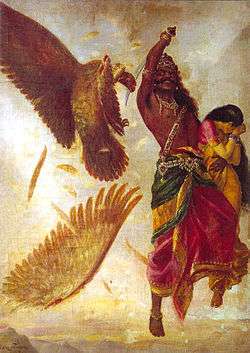
Thirteen years pass and in the last year of exile Rama, Sita and Lakshmana journey southward along the banks of river Godavari, where they build cottages and live off the land. At the Panchavati forest they are visited by a rakshasa(demon) woman, Surpanakha, sister of Ravana. She attempts to seduce the brothers and failing in this, attempts to kill Sita. Lakshmana stops her by cutting off her nose and ears. Hearing of this, her demon brother, Khara, organises an attack against the princes. Rama annihilates Khara and his demons.
When news of these events reaches Ravana, he resolves to destroy Rama by capturing Sita with the aid of the rakshasa Maricha. Maricha, assuming the form of a golden deer, captivates Sita's attention. Entranced by the beauty of the deer, Sita pleads with Rama to capture it. Lord Rama, aware that this is the ploy of the demons, cannot dissuade Sita from her desire and chases the deer into the forest, leaving Sita under Lakshmana's guard. After some time, Sita hears Rama calling out to her; afraid for his life, she insists that Lakshmana rush to his aid. Lakshmana tries to assure her that Rama is invincible and that it is best if he continues to follow Rama's orders to protect her. On the verge of hysterics, Sita insists that it is not she but Rama who needs Lakshmana's help. He obeys her wish but stipulates that she is not to leave the cottage or entertain any strangers. He draws a chalk outline, the Lakshmana rekha, around the cottage and casts a spell on it that prevents anyone from entering the boundary but allows people to exit. With the coast finally clear, Ravana appears in the guise of an ascetic requesting Sita's hospitality. Unaware of the devious plan of her guest, Sita is tricked into leaving the rekha and is then forcibly carried away by the evil Ravana.
Jatayu, a vulture, tries to rescue Sita, but is mortally wounded. At Lanka, Sita is kept under the heavy guard of rakshasis. Ravana demands Sita marry him, but Sita, eternally devoted to Rama, refuses. Rama and Lakshmana learn about Sita's abduction from Jatayu and immediately set out to save her. During their search, they meet the demon Kabandha and the ascetic Shabari, who direct them towards Sugriva and Hanuman.
Kishkindha Kanda
Kishkindha Kanda is set in the ape(Vanar) citadel Kishkindha. Rama and Lakshmana meet Hanuman, the bigest devotee of Rama, greatest of ape heroes and an adherent of Sugriva, the banished pretender to the throne of Kishkindha. Rama befriends Sugriva and helps him by killing his elder brother Vali thus regaining the kingdom of Kishkindha, in exchange for helping Rama to recover Sita. However Sugriva soon forgets his promise and spends his time in enjoying his powers. The clever former ape queen Tara(wife of Vali) calmly intervenes to prevent an enraged Lakshmana from destroying the ape citadel. She then eloquently convinces Sugriva to honour his pledge. Sugriva then sends search parties to the four corners of the earth, only to return without success from north, east and west. The southern search party under the leadership of Angad and Hanuman learns from a vulture named Sampati(elder brother of Jatayu), that Sita was taken to Lanka.
Sundara Kanda
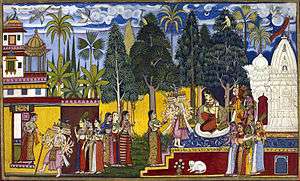
Sundara Kanda forms the heart of Valmiki's Ramayana and consists of a detailed, vivid account of Hanuman's adventures. After learning about Sita, Hanuman assumes a gargantuan form and makes a colossal leap across the sea to Lanka. On the way he faces many challenges like facing a Gandharva kanya who comes in the form of demon to test his abilities. He faces a mountain named Mainakudu who offers Lord Hanuman assistance and offers him rest. Lord Hanuman refuses because there is little time remaining to complete the search for Sita.
After entering into Lanka, he finds a demon, Lankini, who protects the entire Lanka. Hanuman fights with her and kills her in order to get into Lanka. Here, Hanuman explores the demons' kingdom and spies on Ravana. He locates Sita in Ashoka grove, where she is being wooed and threatened by Ravana and his rakshasis to marry Ravana. Hanuman reassures Sita, giving Rama's signet ring as a sign of good faith. He offers to carry Sita back to Rama; however she refuses and says that it is not the dharma. She says that Rama himself must come and avenge the insult of her abduction.
Hanuman then wreaks havoc in Lanka by destroying trees and buildings and killing Ravana's warriors. He allows himself to be captured and delivered to Ravana. He gives a bold lecture to Ravana to release Sita. He is condemned and his tail is set on fire, but he escapes his bonds and leaping from roof to roof, sets fire to Ravana's citadel and makes the giant leap back from the island. The joyous search party returns to Kishkindha with the news.
Yuddha Kanda

Also known as Lanka Kanda, this book describes Ramayana War between the army of Rama and the army of Ravana. Having received Hanuman's report on Sita, Rama and Lakshmana proceed with their allies towards the shore of the southern sea. There they are joined by Ravana's renegade brother Vibhishana. The apes named Nala and Nila construct a floating bridge(known as Rama Setu) across the sea, using stones that floated on water because they had Rama's name written on them. The princes and their army cross over to Lanka. A lengthy war ensues. During a battle, Ravana's son Indrajit hurls a powerful weapon at Lakshmana, who is badly wounded and is nearly killed. So Hanuman assumes a gigantic form and flies from Lanka to the Himalayas. Upon reaching Mount Sumeru, Hanuman was unable to identify the herb that could cure Lakshmana and so decided to bring the entire mountain back to Lanka. Eventually, the war ends when Rama kills Ravana. Rama then installs Vibhishana on the throne of Lanka.
On meeting Sita, Rama asks her to undergo an Agni Pariksha(test of fire) to prove her purity, as he wants to get rid of the rumours surrounding Sita's purity. When Sita plunges into the sacrificial fire, Agni, lord of fire raises Sita, unharmed, to the throne, attesting to her purity. The episode of Agni Pariksha varies in the versions of Ramayana by Valmiki and Tulsidas. In earlier versions, this event does not occur and many scholars consider it to have been added later as society became more patriarchal. In Tulsidas's Ramacharitamanas, Sita was under the protection of Agni(see Maya Sita) so it was necessary to bring her out before reuniting with Rama. At the expiration of his term of exile, Rama returns to Ayodhya with Sita and Lakshmana, where the coronation is performed. This is the beginning of Ram Rajya, which implies an ideal state with good morals.
Uttara Kanda
_LACMA_AC1999.127.45.jpg)
Uttara Kanda is regarded to be a later addition to the original story by Valmiki and concerns the final years of Rama, Sita and Rama's brothers. After being crowned king, Rama passes time pleasantly with Sita. After some time, Sita gets pregnant with twin children. However, despite Agni Pariksha(fire ordeal) of Sita, rumours about her purity are spreading among the populace of Ayodhya. Rama yields to public opinion and reluctantly banishes Sita to the forest, where the sage Valmiki provides shelter in his ashrama(hermitage). Here, she gives birth to twin boys, Lava and Kusha, who become pupils of Valmiki and are brought up in ignorance of their identity.
Valmiki composes the Ramayana and teaches Lava and Kusha to sing it. Later, Rama holds a ceremony during Ashwamedha yagna, which sage Valmiki, with Lava and Kusha, attends. Lava and Kusha sing the Ramayana in the presence of Rama and his vast audience. When Lava and Kusha recite about Sita's exile, Rama becomes grief-stricken and Valmiki produces Sita. Sita calls upon the earth, her mother, to receive her and as the ground opens, she vanishes into it. Rama then learns that Lava and Kusha are his children. Many years later, a messenger from the Gods appears and informs Rama that the mission of his incarnation was over. Rama returns to his celestial abode alongwith his brothers. It was dramatised as Uttararamacarita by Sanskrit poet Bhavabhuti.
Versions
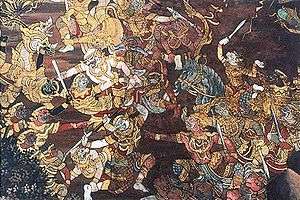

As in many oral epics, multiple versions of the Ramayana survive. In particular, the Ramayana related in north India differs in important respects from that preserved in south India and the rest of south-east Asia. There is an extensive tradition of oral storytelling based on Ramayana in Indonesia, Cambodia, Philippines, Thailand, Malaysia, Laos, Vietnam and Maldives. Father Kamil Bulke, author of Ramakatha, has identified over 300 variants of the Ramayana.
In India
The 7th century CE Bhatti's poem Bhaṭṭikāvya of Bhaṭṭi is a Sanskrit retelling of the epic that simultaneously illustrates the grammatical examples for Pāṇini's Aṣṭādhyāyī as well as the major figures of speech and the Prakrit language.
There are diverse regional versions of the Ramayana written by various authors in India. Some of them differ significantly from each other. During 12th century, Kamban wrote Ramavataram, known popularly as Kambaramayanam in Tamil. A Telugu version, Ranganatha Ramayanam, was written by Gona Budda Reddy in 14th century. The earliest translation to a regional Indo-Aryan language is the early-14th century Saptakanda Ramayana in Assamese by Madhava Kandali. Valmiki's Ramayana inspired Sri Ramacharit Manas by Tulsidas in 1576, an epic Awadhi(a dialect of Hindi) version with a slant more grounded in a different realm of Hindu literature, that of bhakti; it is an acknowledged masterpiece of India, popularly known as Tulsi-krita Ramayana. Gujarati poet Premanand wrote a version of the Ramayana in 17th century. Other versions include Krittivasi Ramayan, a Bengali version by Krittibas Ojha in the 15th century; Vilanka Ramayana by 15th century poet Sarala Dasa[9] and Dandi Ramayana(also known as Jagamohana Ramayana) by 16th century poet Balarama Dasa both in Odia; a Torave Ramayana in Kannada by 16th-century poet Narahari; Adhyathmaramayanam, a Malayalam version by Thunchaththu Ramanujan Ezhuthachan in 16th century; in Marathi by Sridhara in 18th century; in Maithili by Chanda Jha in the 19th century; and in 20th century, Rashtrakavi Kuvempu's Sri Ramayana Darshanam in Kannada.
There is a sub-plot to the Ramayana, prevalent in some parts of India, relating the adventures of Ahiravan and Mahi Ravana, evil brother of Ravana, which enhances the role of Hanuman in the story. Hanuman rescues Rama and Lakshmana after they are kidnapped by the Ahi-Mahi Ravana at the behest of Ravana and held prisoner in a subterranean cave, to be sacrificed to the goddess Kali. Adbhuta Ramayana is a version that is obscure but also attributed to Valmiki - intended as a supplementary to original Valmiki Ramayana. In this variant of the narrative, Sita is accorded far more prominence such as elaboration of the events surrounding her birth — in this case to Ravana's wife, Mandodari as well as her conquest of Ravana's older brother in her Mahakali form.
Mappillapattu—a genre of song popular among the Muslims belonging to Kerala and Lakshadweep—has incorporated some episodes from the Ramayana into its songs. These songs, known as mappila ramayana, have been handed down from one generation to the next orally. In mappila ramayana, the story of Ramayana has been changed into that of a sultan and there are no major changes in the names of characters except for that of Rama which is Laman in many places. The language and the imagery projected in the mappilapattu are in accordance with the social fabric of the earlier Muslim community.
Buddhist Version
In Buddhist variant of the Ramayana (Dasarathajātaka, #467), Dasharatha was king of Benares and not Ayodhya. Rama [called Rāmapaṇḍita in this version] was son of Kaushalya, first wife of Dasharatha, Lakṣmaṇa [Lakkhaṇa] was sibling of Rama and son of Sumitra, second wife of Dasaratha and Sita wife of Rama. To protect his children from his wife Kaikeyi, who wished to promote her son Bharata, Dasharatha sent the three to a hermitage in the Himalayas for a twelve-year exile. After nine years, Dasharatha died and Lakkhaṇa and Sita returned; Rāmapaṇḍita, in deference to his father's wishes, remained in exile for a further two years. This version does not include the abduction of Sītā.
In the explanatory commentary on Jātaka, Rāmapaṇḍita is said to have been a previous incarnation of Buddha and Sita an incarnation of Yasodharā.
Sikh Version
In Guru Granth Sahib, there is description of two types of Ramayana. One is a spiritual Ramayana which is actual subject of Guru Granth Sahib, in which Ravan is ego, Sita is budhi (intellect), Rama is inner soul and Laxman is mann (attention, mind). Guru Granth Sahib also believes in existence of dasavtara who were kings of their times which tried their best to bring revolution in the world. King Ramchandra was one of those and it is not covered in Guru Granth Sahib. Guru Granth Sahib states:
- ਹੁਕਮਿ ਉਪਾਏ ਦਸ ਅਉਤਾਰਾ॥
- हुकमि उपाए दस अउतारा॥
- By hukam(supreme command), he created his ten incarnations,
This version of the Ramayana was written by Guru Gobind Singh, which is part of Dasam Granth. In Dasam Granth, Guru Gobind Singh also explained that he does not believe Ramchandra as a God. He is equating Ramchandra with a common man.
He also said that the almighty, invisible, all prevailing God created so many of Indras, Moons and Suns, Deities, Demons and sages, so many saints and Brahmanas(enlightened people). But they too were caught in the noose of death (KAAL)(Transmigration of the soul). This is very well same to as explained in Bhagavad Gita which is part of the Mahabharata.
Jain Version
Jain versions of the Ramayana can be found in the various Jain agamas like Padmapurana(story of Padmaja and Rama, Padmaja being the name of Sita), Hemacandra's Trisastisalakapurusa charitra(hagiography of 63 illustrious persons), Sanghadasa's Vasudevahindi and Uttarapurana by Gunabhadara. According to Jain cosmology, every half time cycle has nine sets of Balarama, Vasudeva and prativasudeva. Rama, Lakshmana and Ravana are eighth baladeva, vasudeva and prativasudeva respectively. Padmanabh Jaini notes that, unlike in the Hindu puranas, the names Baladeva and Vasudeva are not restricted to Balarama and Krishna in Jain Puranas. Instead they serve as names of two distinct class of mighty brothers, who appear nine times in each half time cycle and jointly rule the half the earth as half-chakravartins. Jaini traces the origin of this list of brothers to the jinacharitra (lives of jinas) by Acharya Bhadrabahu(3–4th century BCE).
In the Jain epic of Ramayana, it is Lakshmana who ultimately kills Ravana and not Rama as told in the Hindu version. In the end, Rama who led an upright life renounces his kingdom, becomes a Jain monk and attains moksha. On the other hand, Lakshmana and Ravana go to hell. However, it is predicted that ultimately they both will be reborn as upright persons and attain liberation in their future births. According to Jain texts, Ravana will be the future Tirthankara(omniscient teacher) of Jainism.
The Jain versions have some variations from Valmiki's Ramayana. Dasharatha, the king of Saketa had four queens: Aparajita, Sumitra, Suprabha and Kaikeyi. These four queens had four sons. Aparajita's son was Padma and he became known by the name of Rama. Sumitra's son was Narayana: he became to be known by another name, Lakshmana. Kaikeyi's son was Bharata and Suprabha's son was Shatrughna. Furthermore, not much was thought of Rama's fidelity to Sita. According to Jain version, Rama had four chief-queen's: Maithili, Prabhavati, Ratinibha, and Sridama. Furthermore, Sita takes renunciation as a Jain ascetic after Rama abandons her and is reborn in heaven. Rama, after Lakshmana's death, also renounces his kingdom and becomes a Jain monk. Ultimately, he attains Kevala Jnana omniscience and finally liberation. Rama predicts that Ravana and Lakshmana, who were in fourth hell, will attain liberation in their future births. Accordingly, Ravana is the future tirthankara of next half ascending time cycle and Sita will be his Ganadhara.
In Nepal
Besides being the site of discovery of the oldest surviving manuscript of the Ramayana, Nepal gave rise to two regional variants in mid 19th – early 20th century. One, written by Bhanubhakta Acharya, is considered the first epic of Nepali language, while the other, written by Siddhidas Mahaju in Nepal Bhasa was a foundational influence in the Nepal Bhasa renaissance.
Ramayana written by Bhanubhakta Acharya is one of the most popular verses in Nepal. The popularization of the Ramayana and its tale, originally written in Sanskrit Language was greatly enhanced by the work of Bhanubhakta. Mainly because of his writing of Nepali Ramayana, Bhanubhakta is also called Aadi Kavi or The Pioneering Poet.
Southeast Asian Versions


Phra Lak Phra Lam is a Lao language version, whose title comes from Lakshmana and Rama. The story of Lakshmana and Rama is told as the previous life of Gautama buddha. In Hikayat Seri Rama of Malaysia,[10][11] Dasharatha is the great-grandson of the Prophet Adam. Ravana receives boons from Allah instead of Brahma. In many Malay language versions, Lakshmana is given greater importance than Rama, whose character is considered somewhat weak.
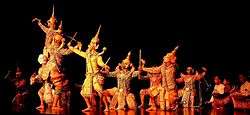

The Cambodian version of the Ramayana, Reamker, is the most famous story of Khmer literature since the Kingdom of Funan era. It adapts the Hindu concepts to Buddhist themes and show's the balance of good and evil in the world. The Reamker has several differences from the original Ramayana, including scenes not included in the original and emphasis on Hanuman and Sovanna Maccha, a retelling which influences the Thai and Lao versions. Reamker in Cambodia is not confined to the realm of literature but extends to all Cambodian art forms, such as sculpture, Khmer classical dance, theater known as lakhorn luang(the foundation of the royal ballet), poetry and the mural and bas reliefs seen at the Silver Pagoda and Angkor Wat.
Thailand's popular national epic Ramakien (Thai:รามเกียรติ์.,from Sanskrit rāmakīrti, glory of Rama) is derived from Hindu epic. In Ramakien, Sita is the daughter of Ravana and Mandodari (thotsakan and montho). Vibhishana(phiphek), the astrologer brother of Ravana, predicts calamity from the horoscope of Sita. Ravana has thrown her into the water, but is later rescued by Janaka(chanok). While the main story is identical to that of Ramayana, many other aspects were transposed into a Thai context, such as the clothes, weapons, topography and elements of nature, which are described as being Thai in style. It has an expanded role for Hanuman and he is portrayed as a lascivious character. Ramakien can be seen in an elaborate illustration at Wat Phra Kaew in Bangkok.
Other Southeast Asian adaptations include Kakawin Ramayana of Java, Ramakavaca of Bali(Indonesia), Maharadia Lawana and Darangen of Moro Muslims of Mindanao(Philippines) and Yama Zatdaw of Myanmar.
Critical edition
A critical edition of the text was compiled in India in the 1960's and 1970's, by the Oriental Institute at Maharaja Sayajirao University of Baroda, India, utilizing dozens of manuscripts collected from across India and the surrounding region.[12] An English language translation of the critical edition was completed in November 2016 by Sanskrit scholar Robert P. Goldman of the University of California, Berkeley.[13]
Influence On Culture & Art
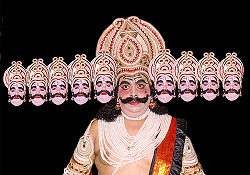
One of the most important literary works of ancient India, the Ramayana has had a profound impact on art and culture in the Indian subcontinent and southeast Asia with the lone exception of Vietnam. The story ushered in the tradition of the next thousand years of massive-scale works in the rich diction of regal courts and Hindu temples. It has also inspired much secondary literature in various languages, notably Kambaramayanam by Tamil poet Kambar of 12th century, Telugu language Molla Ramayanam by poet Molla and Ranganatha Ramayanam by poet Gona Budda Reddy, 14th century Kannada poet Narahari's Torave Ramayana and 15th century Bengali poet Krittibas Ojha's Krittivasi Ramayan, as well as 16th century Awadhi version, Ramacharitamanas, written by Tulsidas.
The Ramayana became popular in southeast Asia during 8th century and was represented in literature, temple architecture, dance and theatre. Today, dramatic enactments of the story of the Ramayana, known as Ramlila, take place all across India and in many places across the globe within the Indian diaspora.
Ramayana has also been depicted in many paintings, most notably by the Malaysian artist Syed Thajudeen in 1972. The epic tale was picturized on canvas in epic proportions measuring 72 x 453 cm in 9 panels. The painting depicts three prolific parts of the epic, namely The Abduction of Sita, Hanuman visits Sita and Hanuman Burns Lanka. The painting is currently in the permanent collection of the Malaysian National Visual Arts Gallery.
Religious Significance
Rama, the hero of the Ramayana, is one of the most popular deities worshipped in the Hindu religion. Each year, many devout pilgrims trace their journey through India and Nepal, halting at each of the holy sites along the way. The poem is not seen as just a literary monument, but serves as an integral part of Hinduism and is held in such reverence that the mere reading or hearing of it or certain passages of it, is believed by Hindus to free them from sin and bless the reader or listener.
According to Hindu tradition, Rama is an incarnation(Avatar) of god Vishnu. The main purpose of this incarnation is to demonstrate the righteous path(dharma) for all living creatures on earth.
Ramayana In Popular Culture
Multiple, modern, English-language adaptations of the epic exist, namely Ram Chandra Series by Amish Tripathi, Ramayana Series by Ashok Banker and mythopoetic novel, Asura: Tale of the Vanquished by Anand Neelakantan. Another Indian author, Devdutt Pattanaik, has published three different retelling and commentaries of Ramayana titled Sita, The Book Of Ram and Hanuman's Ramayan.
A number of plays, movies and television serials have also been produced based upon the Ramayana.
Stage
Starting in 1978 and under the supervision of Baba Hari Dass, Ramayana has been performed every year by Mount Madonna School in Watsonville, California. Currently, it is the largest yearly, Western version of the epic being performed. It takes the form of a colorful musical with custom costumes, sung and spoken dialog, jazz-rock orchestration and dance. This performance takes place in a large audience theater setting usually in June, in San Jose, CA. Baba Hari Dass has taught acting arts, costume-attire design, mask making and choreography to bring alive characters of Sri Ram, Sita, Hanuman, Lakshmana, Shiva, Parvati, Vibhishan, Jatayu, Sugriva, Surpanakha, Ravana and his rakshasa court, Meghnadha, Kumbhakarna and the army of monkeys and demons.
Movies
- Sampoorna Ramayanam (1958 film) – A Tamil movie starring N. T. Rama Rao(1958)
- Sampoorna Ramayana, A Hindi film directed by Babubhai Mistry(1961)
- Lava Kusha – A Uttara Kanda based bilingual Telugu movie and Tamil movie starring N. T. Rama Rao(1963)
- Sampoorna Ramayanamu, A Telugu film directed by Bapu, starring Sobhan Babu, Chandrakala, S V Ranga Rao(1971)
- Kanchana Sita - A Malayalam film by G. Aravindan(1977)
- Ramayana: The Legend of Prince Rama – A Japanese animated film released in Hindi, Japanese and English languages.(1992)
- Opera Jawa – An Indonesian-Austrian film in Indonesian language; inspired by the story of the abduction of Sita(2008).
- Sita Sings the Blues – An independent animated film(2008).
- Lava Kusa: The Warrior Twins – Animated film based on Uttara Kanda(2010).
- Ramayana: The Epic – A Warner Bros. Indian animated film(2010).
- Sri Rama Rajyam – Movie based on Uttara Kanda, Telugu film starring Nandamuri Balakrishna.(2011)
- Yak: The Giant King - A re-interpretation of Ramayana, the Thai animation film tells the story of a giant robot, Na Kiew, who's left wandering in a barren wasteland after a great war. Na Kiew meets Jao Phuek, a puny tin robot who's lost his memory and is now stuck with his new big friend. Together they set out across the desert populated by metal scavengers, to look for Ram, the creator of all robots.(2012)
- Mumbai Musical - DreamWorks Animation(2016).
Plays
- Kanchana Sita (play), Saketham and Lankalakshmi – award winning trilogy by Malayalam playwright C. N. Sreekantan Nair
- Lankeswaran play by award winning Tamil cinema actor R. S. Manohar.
- King's Dharma – A multi-media production produced by Ben Kahan and Andreas Canning(2016).[14]
TV Series
- Ramayan (TV series) – Originally broadcast on Doordarshan, produced by Ramanand Sagar in 1987.
- Jai Hanuman – Originally broadcast on Doordarshan, produced and directed by Sanjay Khan.
- Ramayan (2002) – Originally broadcast on Zee TV, produced by BR Films.
- Ramayan (2008 TV series) – Originally broadcast on Imagine TV, produced by Ramanand Sagar.
- Ramayan (2012 TV Series) – A remake of the 1987 series ans aured on Zee TV.
- Antariksh (2004) – A sci-fi version of Ramayan. Originally broadcast on Star Plus.
- Raavan (TV series) - series on life of Ravana based on Ramayana. Originally broadcast on Zee TV.
- Sankatmochan Mahabali Hanuman - 2015 series based on life of Hanuman presently broadcasting on Sony TV.
- Siya Ke Ram - a series on Star Plus, originally broadcast from November 16, 2015 to November 4, 2016.
See also
- Adam's Bridge
- Indian Numbering System#Vedic numbering systems
- Rama
- Reamker
- Three Hundred Ramayanas: Five Examples and Three Thoughts on Translation, a controversial essay by A. K. Ramanujan
Citations
- ↑ "Ramayana". Random House Webster's Unabridged Dictionary.
- ↑ Mukherjee Pandey, Jhimli (18 Dec 2015). "6th-century Ramayana found in Kolkata, stuns scholars". timesofindia.indiatimes.com. TNN. Retrieved 20 December 2015.
- ↑ Uma Singh, Senu Singh (16 January 2013). "Ramayan as a complete life of real human" (PDF). Indian Journal of Arts. 1 (1): 2. Retrieved 2016-11-20.
- ↑
- ↑
- ↑
- ↑
- ↑ CANTO LXVII.: THE BREAKING OF THE BOW. sacredtexts.com. Retrieved 25 January 2016.
- ↑ Jones, Constance; Ryan, James D. (2006-01-01). Encyclopedia of Hinduism. Infobase Publishing. ISBN 9780816075645.
- ↑ Journal of the Straits Branch of the Royal Asiatic Society. 1898. pp. 107–.
- ↑ Journal of the Straits Branch of the Royal Asiatic Society. 1898. pp. 143–.
- ↑
- ↑
- ↑ "Welcome". King's Dharma. Retrieved 2016-10-10.
References
- Arya, Ravi Prakash (ed.).Ramayana of Valmiki: Sanskrit Text and English Translation. (English translation according to M. N. Dutt, introduction by Dr. Ramashraya Sharma, 4-volume set) Parimal Publications: Delhi, 1998, ISBN 81-7110-156-9
- Bhattacharji, Sukumari (1998). Legends of Devi. Orient Blackswan. p. 111. ISBN 978-81-250-1438-6.
- Brockington, John (2003). "The Sanskrit Epics". In Flood, Gavin. Blackwell companion to Hinduism. Blackwell Publishing. pp. 116–128. ISBN 0-631-21535-2.
- Buck, William; van Nooten, B. A. (2000). Ramayana. University of California Press. p. 432. ISBN 978-0-520-22703-3.
- Dutt, Romesh C. (2004). Ramayana. Kessinger Publishing. p. 208. ISBN 978-1-4191-4387-8.
- Dutt, Romesh Chunder (2002). The Ramayana and Mahabharata condensed into English verse. Courier Dover Publications. p. 352. ISBN 978-0-486-42506-1.
- Fallon, Oliver (2009). Bhatti's Poem: The Death of Rávana (Bhaṭṭikāvya). New York: New York University Press, Clay Sanskrit Library. ISBN 978-0-8147-2778-2.
- Keshavadas, Sadguru Sant (1988). Ramayana at a Glance. Motilal Banarsidass Publ.,. p. 211. ISBN 978-81-208-0545-3.
- Goldman, Robert P. (1990). The Ramayana of Valmiki: An Epic of Ancient India: Balakanda. Princeton University Press. ISBN 978-0-691-01485-2.
- Goldman, Robert P. (1994). The Ramayana of Valmiki: An Epic of Ancient India: Kiskindhakanda. Princeton University Press. ISBN 978-0-691-06661-5.
- Goldman, Robert P. (1996). The Ramayana of Valmiki: Sundarakanda. Princeton University Press. ISBN 978-0-691-06662-2.
- Mahulikar, Dr. Gauri. Effect Of Ramayana On Various Cultures And Civilisations, Ramayan Institute
- Rabb, Kate Milner, National Epics, 1896 – see eText in Project Gutenburg
- Murthy, S. S. N. (November 2003). "A note on the Ramayana" (PDF). Electronic Journal of Vedic Studies. New Delhi. 10 (6): 1–18. ISSN 1084-7561.
- Prabhavananda, Swami (1979). The Spiritual Heritage of India. Vedanta Press. p. 374. ISBN 978-0-87481-035-6. (see also Wikipedia article on book)
- Raghunathan, N. (transl.), Srimad Valmiki Ramayanam, Vighneswara Publishing House, Madras (1981)
- Rohman, Todd (2009). "The Classical Period". In Watling, Gabrielle; Quay, Sara. Cultural History of Reading: World literature. Greenwood. ISBN 978-0-313-33744-4.
- Sattar, Arshia (transl.) (1996). The Rāmāyaṇa by Vālmīki. Viking. p. 696. ISBN 978-0-14-029866-6.
- Sundararajan, K.R. (1989). "The Ideal of Perfect Life : The Ramayana". In Krishna Sivaraman; Bithika Mukerji. Hindu spirituality: Vedas through Vedanta. The Crossroad Publishing Co. pp. 106–126. ISBN 978-0-8245-0755-8.
- A different Song – Article from "The Hindu" 12 August 2005 – "The Hindu : Entertainment Thiruvananthapuram / Music : A different song". Hinduonnet.com. 12 August 2005. Archived from the original on 27 October 2010. Retrieved 1 September 2010.
- Valmiki's Ramayana illustrated with Indian miniatures from the 16th to the 19th century, 2012, Editions Diane de Selliers, ISBN 9782903656768
Further reading
- Sanskrit text
- Electronic version of the Sanskrit text, input by Muneo Tokunaga
- Sanskrit text on GRETIL
- Translations
- Valmiki Ramayana verse translation by Desiraju Hanumanta Rao, K. M. K. Murthy et al.
- Valmiki Ramayana translated by Ralph T. H. Griffith (1870–1874) (Project Gutenberg)
- The Ramayana condensed into English verse by R. C. Dutt (1899) at archive.org
- Prose translation of the complete Ramayana by M. N. Dutt (1891–1894): Balakandam, Ayodhya Kandam, Aranya Kandam, Kishkindha Kandam, Sundara Kandam, Yuddha Kandam, Uttara Kandam
- Rāma the Steadfast: an early form of the Rāmāyaṇa translated by J. L. Brockington and Mary Brockington. Penguin, 2006. ISBN 0-14-044744-X.
- Geet Ramayan literally "Ramayan in verse" in Marathi by G. D. Madgulkar
- Secondary Sources
- Jain, Meenakshi. (2013). Rama and Ayodhya. Aryan Books International, 2013.
External links
| Wikiquote has quotations related to: Ramayan |
| Sanskrit Wikisource has original text related to this article: |
| Wikisource has original text related to this article: |
| Wikimedia Commons has media related to: |
- A condensed verse translation by Romesh Chunder Dutt sponsored by the Liberty Fund
- The Ramayana as a Monomyth from UC Berkeley (archived)
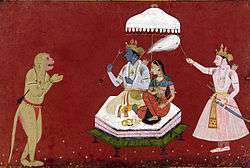
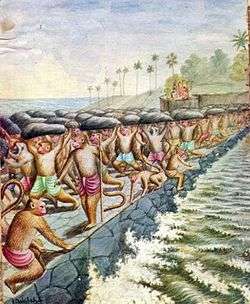

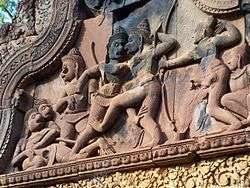
.jpg)
